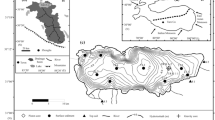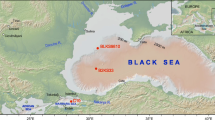Abstract
A high-resolution pollen record of the past 13000 a from Huguangyan Maar Lake reveals the vegetation and environment changes in southern China during the Holocene. It shows that (i) pollen percentage of trees and shrubs reached 56% during the early Holocene (11600–7800 cal a BP), of which the pollen percentage of tropical trees reached a maximum at 9500-8000 cal a BP, reflecting a hot and wet environment; (ii) during the mid-Holocene (7800–4200 cal a BP), the pollen percentage of montane coniferous trees and herbs increased, while the percentage of tropical-subtropical trees decreased, indicating lower temperature and humidity; (iii) in the late Holocene spanning from 4200 to 350 cal a BP, the pollen percentage of herbs and montane conifer increased significantly, indicating a marked decrease of temperature and humidity. Our pollen data reveal that the time period 9500–8000 cal a BP in southern China represents a climatic optimum for the Holocene characterized by hot and wet conditions. This is consistent with the Holocene optimum found in lower latitude regions globally. We speculate that strong insolation might cause the northward migration of the ITCZ and subtropical summer monsoon front, which resulted in an early Holocene optimum in the Huguangyan area. The dry tendency and climate fluctuations of the middle and late Holocene could be associated with a decrease in solar insolation and frequent ENSO event.
Similar content being viewed by others
References
Zhu K Z. Study on the climate changes during the past 5000 years in China. J Archaeol (in Chinese), 1972, (1): 15–38
Shi Y F, Kong Z C, Wang S M, et al. The climatic fluctuation and important events of Holocene Megathermal in China. Sci China Ser B, 1994, 37(3): 353–365
Wu X H, An Z S, Wang S M, et al. The temporal and spatial variation of East-Asian summer monsoon in Holocene Optimum in China. Quat Sci (in Chinese), 1994, (1): 24–37
An Z S, Porter S C, Kutzbach J E, et al. Asynchronous Holocene optimum of the East Asian monsoon. Quat Sci Rev, 2000, 19(8):743–762
Zheng Z, Wang J H, Wang B, et al. High-resolution records of Holocene from the Shuangchi Maar Lake in Hainan Island. Chin Sci Bull, 2003, 48(5): 497–502
Huang C C, Zhou J, Pang J L, et al. A regional aridity phase and its possible cultural impact during the Holocene Magathermal in the Guanzhong Basin, China. Holocene, 2000, 10(1): 135–142
Shao X H, Wang Y J, Cheng H, et al. Long-term trend and abrupt events of the Holocene Asian monsoon inferred from a stalagmite δ 18O record from Shennongjia in Central China. Chin Sci Bull, 2006, 51(2): 221–228
Zhou W J, Yu X F, Jull A J T, et al. High-resolution evidence from southern China of an early Holocene optimum and a mid-Holocene dry event during the past 18000 years. Quat Res, 2004, 62(1): 39–48
Yang C F, Jiao X L, Peng C. The tropical belt of convergence and the climate of South China Sea. Mar Sci Bull (in Chinese), 2003, 22(6): 83–87
Wang W Y, Liu J Q, Liu T S, et al. The two-step monsoon changes of the last deglaciation recorded in tropical Maar Lake Huguangyan, southern China. Chin Sci Bull, 2000, 45(16): 1529–1532
Liu J Q, Lü H Y, Negendank J, et al. Periodicity of Holocene climatic variations in the Huguangyan Maar Lake. Chin Sci Bull, 2000, 45(18): 1712–1717
Chu G Q, Liu J Q, Sun Q, et al. The ‘Mediaeval Warm Period’ drought recorded in Lake Huguangyan, tropical south China. Holocene, 2002, 12(5): 511–516
Lü H Y, Liu J Q, Chu G Q, et al. A study of pollen and environment in the Huguangyan Maar Lake since the last Glaciation. Acta Palaeontol Sin (in Chinese), 2003, 42(2): 284–291
Fuhrmann A, Mingram J, Lücke A, et al. Variations in organic matter composition in sediments from Lake Huguang Maar (Huguangyan), South China during the last 68 ka: Implications for environmental and climatic change. Org Geochem, 2003, 34(11): 1497–1515
Mingram J, Schettler G, Nowaczyk N R, et al. The Huguang Maar Lake—A high-resolution record of palaeoenvironmental and palaeoclimatic changes over the last 78000 years from South China. Quat Res, 2004, 122(1): 85–107
Liu Q, Gu Z Y, Liu J Q, et al. Bulk organic carbon isotopic record of Huguangyan Maar Lake, Southeastern China and its paleoclimatic and paleoenvironmental significance since 62 ka BP. Mar Geol Quat Geol (in Chinese), 2005, 25(2): 115–126
Wang S Y, Lü H Y, Liu J Q. Timing of the last deglacial warming in low and middle latitudes of china: Compared with bipolar ice core. Quat Sci (in Chinese), 2006, 26(2): 283–292
Guo Z F, Liu J Q, Chu G Q. Composition and origin of tephra of the Huguangyan Maar Lake. Quat Sci (in Chinese), 2002, 22(3): 266–272
Yancheva G, Nowaczyk N R, Mingram J, et al. Influence of the Intertropical Convergence Zone on the East Asian monsoon. Nature, 2007, 445: 74–77
Wang Y J, Cheng H, Edwards R L, et al. A high-resolution absolute-dated late Pleistocene monsoon record from Hulu Cave, China. Science, 2001, 294: 2345–2348
Demske D, Heumann G, Granoszewski W, et al. Late glacial and Holocene vegetation and regional climate variability evidenced in high-resolution pollen records from Lake Baikal. Glob Planet Change, 2005, 46(1–4): 255–279
Yu G, Han H Y. Simulations of pollen and tropical vegetation of surface soil in Hainan Island, China. Mar Geol Quat Geol (in Chinese), 1998, 18(3): 103–112
Wang F X, Qian N F, Zhang Y L, et al. Pollen Flora of China (in Chinese). 2nd ed. Beijing: Science Press, 1995. 31–32
Sun X J, Wu Y S. Distribution and quantity of sporopollen and algae in surface sediments of the Dianchi Lake,Yunnan Province. Mar Geol Quat Geol (in Chinese), 1987, 7(4): 81–92
Zhang H, Zheng Z, Wang J H, et al. Climate changes for the last 2500 years based on Pediastrum record from Hainan Island. Trop Geogr (in Chinese), 2004, 24(2): 109–123
Yu K F, Liu D S, Shen C D, et al. High-frequency climatic oscillations recorded in a Holocene coral reef at Leizhou Peninsula, South China Sea. Sci China Ser D-Earth Sci, 2002, 45(12): 1057–1068
Xiao J L, Wu J T, SI B, et al. Holocene climate changes in the monsoon/arid transition reflected by carbon concentration in Daihai Lake of Inner Mongolia. Holocene, 2006, 16(4): 551–560
Gasse F. Hydrological changes in the African tropics since the last glacial maximum. Quat Sci Rev, 2000, 19: 189–211
Fleitmann D, Burns S J, Mudelsee M, et al. Holocene forcing of the Indian Monsoon recorded in a stalagmite from Southern Oman. Science, 2003, 300: 1737–1739
Elise Van Campo. Monsoon fluctuations in two 20000-yr BP Oxygen-isotope/pollen records off Southwest India. Quat Res, 1986, 26(3): 376–388
Zhang L S, Fang X Q, Ren G Y. Global Change (in Chinese). Beijing: Higher Education Press: 2000. 180–183
Dykoski C A, Edwards R L, Cheng H, et al. A high-resolution, absolute-dated Holocene and deglacial Asian monsoon record from Dongge Cave, China. Earth Planet Sci Lett, 2005, 233(1–2): 71–86
Hong Y T, Hong B, Lin Q H, et al. Inverse phase oscillations between the East Asian and Indian Ocean summer monsoons during the last 12000 years and paleo-El Niño. Earth Planet Sci Lett, 2005, 231(3–4): 337–346
Gupta A K, Anderson D M, Overpeck J T. Abrupt changes in the Asian southwest monsoon during the Holocene and their links to the North Atlantic Ocean. Nature, 2003, 421: 354–357
Chen F H, Huang X Z, Yang M L, et al. Westerly dominated Holocene climate model in arid central Asia—case study on Bosten Lake, Xinjiang, China. Quat Sci (in Chinese), 2006, 26(6): 881–887
Wright Jr H E, Kutzbach J, Webb E T, et al. III Global climates since the last glacial maximum. Minneapolis: University of Minnesota Press, 1993. 468–513
Hastenrath S, Greischar L. Circulation mechanisms related to northeast Brazil rainfall anomalies. J Geophys Res, 1993, 98: 5093–5102
Guo Z T, Petit-Maire N, Kropelin S. Holocene non-orbital climatic events in present-day arid areas of northern Africa and China. Glob Planet Change, 2000, 26: 97–103
Gasse F, Van Campo E. Abrupt post-glacial climate events in West Asia and North Africa monsoon domains. Earth Planet Sci Lett, 1994, 126: 435–456
Huang J. Impact of ENSO on the tropical cyclones affecting Guangdong. Meteorol Monthly (in Chinese), 2006, 32(9): 55–59
Liu J X, Shi N. Climatic characters and changes of tropical precipitation fields during 1948–2003. J Nanjing Institute Meteorol (in Chinese), 2006, 29(5): 627–634
Haug G H, Hughen K A, Sigman D M, et al. Southward migration of the Intertropical Convergence Zone through the Holocene. Science, 2001, 293: 1304–1308
Moy C M, Seltzer G O, Rodbell D T, et al. Variability of El Niño/Southern Oscillation activity at millennial timescales during the Holocene epoch. Nature, 2002, 420: 162–165
An C B, Feng Z D, Barton L. Dry or humid? Mid-Holocene humidity changes in arid and semi-arid China. Quat Sci Rev, 2006, 25(3–4): 351–361
Author information
Authors and Affiliations
Corresponding author
Additional information
Supported by the National Natural Science Foundation of China for Distinguished Youth Scholar (Grant No. 40325002), the Key Research Project of the Knowledge Innovation Program of CAS (Grant Nos. KZCX3-SW-145 and KZCX2-YW-117), the National Basic Research Program of China (Grant No. 2005CB422002-2), and the National Natural Science Foundation of China (Grant No. 40331011)
About this article
Cite this article
Wang, S., Lü, H., Liu, J. et al. The early Holocene optimum inferred from a high-resolution pollen record of Huguangyan Maar Lake in southern China. CHINESE SCI BULL 52, 2829–2836 (2007). https://doi.org/10.1007/s11434-007-0419-2
Received:
Accepted:
Issue Date:
DOI: https://doi.org/10.1007/s11434-007-0419-2




